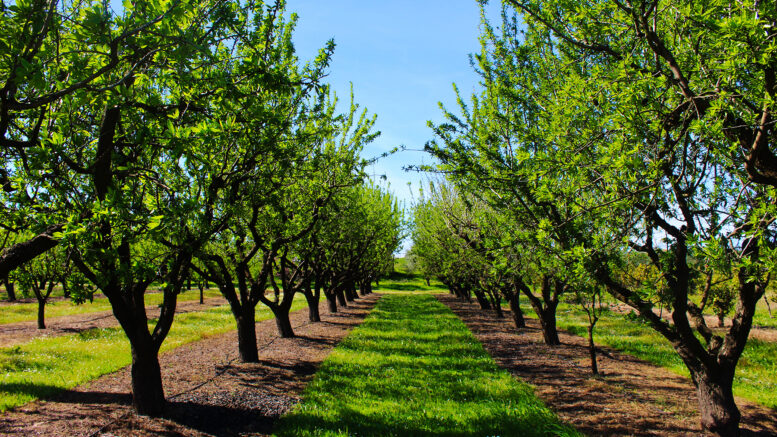Application of compost to California almond orchards resulted in a strong increase in yield according to research presented at Compost2024—the annual conference of the U.S. Composting Council, held January 27-30, in Daytona Beach.
The research was presented by Alexia Cooper, an environmental systems graduate researcher at University of California, Merced. Her current research involves assessing the effects of compost and cover crops in nut orchard systems within California’s Central Valley. Cooper said California produces 13% of the food in the U.S., including 80% of the world’s almonds. She said the expansion of almond production in California has led to heightened concerns about the environmental impact of conventional agricultural practices on soil health, water quality and ecosystem sustainability.
A five-year study, currently in year three, is being conducted in commercial almond orchards and focuses on the dynamics of nitrogen availability, variations in soil carbon content, microbial activity and the subsequent effects on tree health due to the application of compost and cover crop practices.
“The research question we had was, can compost and cover crops improve soil health in orchards, and then, does this result in improvements to tree health and yields,” Cooper said. “One of the main goals for the orchards we worked with was to reduce risks and barriers in adopting new practices by conducting site specific trials and compensating the participating farmers.”
In the project, compost and cover crops were integrated. A “soil builder” mix was incorporated with the goal of decreasing soil compaction and increasing water availability to decrease soil evaporation, then to improve chemical, biological and physical soil health indices. Cover crops were seeded in November each year right before the area’s wet season at a rate of 75 pounds per acre.
Compost-application test sites utilized Synagro AllGro, incorporated at eight tons per acre.
“We applied it to both alleys and berms, which is a novel practice for California,” Cooper said. “Often, if they do apply compost, it’s only to the berms. But after looking at these orchard sites, we saw that almost a third of the site was alley. So we wanted to apply compost there because that actually has a pretty big impact on where trees uptake water. The carbon content of the compost was 27%, the nitrogen content 3.3% and [carbon to nitrogen ratio] of eight to one, which is pretty desirable to quickly provide available nitrogen for our experimental design.”
In conventional orchard management, herbicides are applied to get rid of all vegetation in the alleys of the orchards.
“The main input of nutrients is from the nitrate fertilizer and if that nitrate isn’t not immediately taken up by the trees, we have nitrate leaching which can have negative effects for human health and ecological health,” Cooper said. “In the conventional orchard management, some of the soil conditions that we were seeing was very low microbial activity, low soil organic matter, high compaction and very low water holding capacity.”
In the integrative soil health management testing, compost added organic matter to the soil.
“The soil organic matter has inorganic and organic forms of nitrogen, but it requires microbial mediation to make it into ammonium,” Cooper said. “So we have this mineralization process to create an ammonium pool, which is less mobile in the soil than nitrate. The cover crops can then biologically fix nitrogen with the types of legumes that we have.”
After the first year, a slight increase in microbial biomass was seen across all test sites.
“In year two, it seems like a much stronger result,” she said. “This increase in microbial biomass nitrogen suggests heightened microbial mediated nitrogen cycling processes. … In year one, we saw an immediate availability increase in ammonium, which is sustained throughout the growing season.
In year two, we see even a higher spike in ammonium availability, which was really exciting to see such strong results. For nitrate, we were concerned if we’re applying compost, are we seeing higher nitrates too? We didn’t find that.”
Significantly, Cooper said, the testing showed a strong increase in yields of “fifth leaf almonds.”
“In the first year we saw a really small increase in 2022 but this last year we saw a 102% increase, resulting in about a six pound per tree increase, which was really exciting,” Cooper said.
Cooper said California is experiencing intense flooding and current almond orchard management systems have decreased the crop’s resilience and has resulted in declining soil health.
“We’re facing issues of compaction, soil erosion and the effects of high inputs of NPK, which then are causing high nitrate levels in California’s waters, which not only have effects to human health, but also ecological health,” she said. “It doesn’t have to be the way it is. There is an alternative path for adopting integrative soil health practices that is more regeneratively functioning. We hope that these initiatives we can foster increased tree health, productivity and resiliency to climate change.”
Follow us on social media:


Be the first to comment on "Compost increases almond yield"